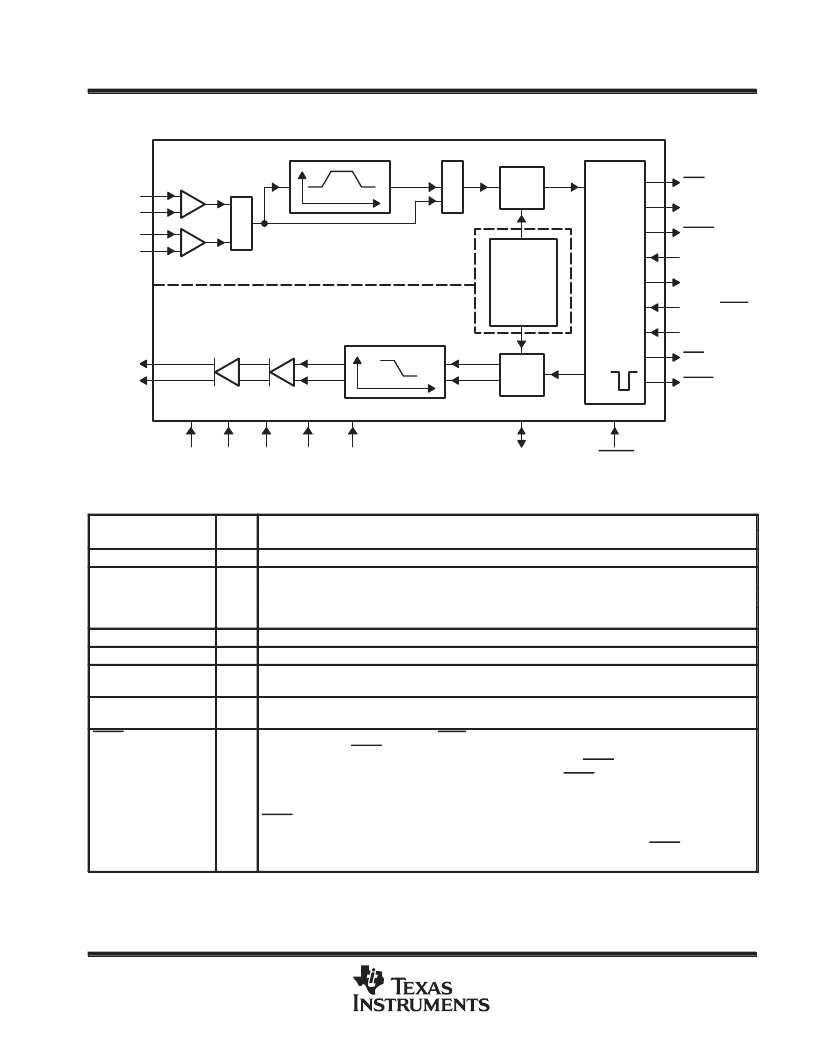- 您現(xiàn)在的位置:買賣IC網(wǎng) > PDF目錄383953 > TLC32040C (Texas Instruments, Inc.) ANALOG INTERFACE CIRCUITS PDF資料下載
參數(shù)資料
| 型號: | TLC32040C |
| 廠商: | Texas Instruments, Inc. |
| 英文描述: | ANALOG INTERFACE CIRCUITS |
| 中文描述: | 模擬接口電路 |
| 文件頁數(shù): | 3/33頁 |
| 文件大小: | 453K |
| 代理商: | TLC32040C |
第1頁第2頁當(dāng)前第3頁第4頁第5頁第6頁第7頁第8頁第9頁第10頁第11頁第12頁第13頁第14頁第15頁第16頁第17頁第18頁第19頁第20頁第21頁第22頁第23頁第24頁第25頁第26頁第27頁第28頁第29頁第30頁第31頁第32頁第33頁

TLC32040C, TLC32040I, TLC32041C, TLC32041I
ANALOG INTERFACE CIRCUITS
SLAS014E – SEPTEMBER 1987 – REVISED MAY 1995
3
POST OFFICE BOX 655303
DALLAS, TEXAS 75265
functional block diagram
M
U
X
M
U
X
IN+
IN–
AUX IN +
AUX IN –
Internal
Voltage
Reference
(TLC32040
only)
Serial
Port
A/D
OUT+
OUT–
D/A
Band-Pass Filter
Transmit Section
+
–
+
–
SHIFT CLK
MSTR CLK
EODR
DR
FSR
WORD/BYTE
DX
FSX
EODX
VCC+VCC–ANLG
GND
DTGL
GND
VDD
(DIGITAL)
REF
RESET
Low-Pass Filter
Terminal Functions
TERMINAL
NAME
ANLG GND
AUX IN+
I/O
DESCRIPTION
NO.
17,18
24
Analog ground return for all internal analog circuits. Not internally connected to DGTL GND.
Noninverting auxiliary analog input state. This input can be switched into the bandpass filter and A/D
th i
t l If th
i t bit i th
converter path via software control. If the appropriate bit in the control register is a 1, the auxiliary inputs
replace the IN+ and IN– inputs. If the bit is a 0, the IN+ and IN– inputs are used (see the AIC DX data word
re lace the IN+ and IN in uts. If the bit is a 0, the IN+ and IN in uts are used (see the AIC DX data word
format section).
I
t l
i t
1 th
AUX IN–
23
I
Inverting auxiliary analog input (see the above AUX IN+ description)
DGTL GND
9
Digital ground for all internal logic circuits. Not internally connected to ANLG GND.
DR
5
O
DR is used to transmit the ADC output bits from the AIC to the TMS320 serial port. This transmission of bits
from the AIC to the TMS320 serial port is synchronized with the SHIFT CLK signal.
DX
12
I
DX is used to receive the DAC input bits and timing and control information from the TMS320. This serial
transmission from the TMS320 serial port to the AIC is synchronized with the SHIFT CLK signal.
EODR
3
O
End of data receive. See the WORD/BYTE description and the Serial Port Timing diagrams. During the
word-mode timing, EODR is a low-going pulse that occurs immediately after the 16 bits of A/D information
have been transmitted from the AIC to the TMS320 serial port. EODR can be used to interrupt a
microprocessor upon completion of serial communications. Also, EODR can be used to strobe and enable
external serial-to-parallel shift registers, latches, or external FIFO RAM, and to facilitate parallel data bus
communications between the AIC and the serial-to-parallel shift registers. During the byte-mode timing,
EODR goes low after the first byte has been transmitted from the AIC to the TMS320 serial port and is kept
low until the second byte has been transmitted. The TMS32011 or TMS320C17 can use this low-going
signal to differentiate between the two bytes as to which is first and which is second. EODR does not occur
after secondary communication.
相關(guān)PDF資料 |
PDF描述 |
|---|---|
| TLC32040I | ANALOG INTERFACE CIRCUITS |
| TLC32041C | ANALOG INTERFACE CIRCUITS |
| TLC32041CFN | ANALOG INTERFACE CIRCUITS |
| TLC32041I | ANALOG INTERFACE CIRCUITS |
| TLC32040M | ANALOG INTERFACE CIRCUIT |
相關(guān)代理商/技術(shù)參數(shù) |
參數(shù)描述 |
|---|---|
| TLC32040CFN | 制造商:TI 制造商全稱:Texas Instruments 功能描述:ANALOG INTERFACE CIRCUITS |
| TLC32040CN | 制造商:TI 制造商全稱:Texas Instruments 功能描述:ANALOG INTERFACE CIRCUITS |
| TLC32040I | 制造商:TI 制造商全稱:Texas Instruments 功能描述:ANALOG INTERFACE CIRCUITS |
| TLC32040IN | 制造商:TI 制造商全稱:Texas Instruments 功能描述:ANALOG INTERFACE CIRCUITS |
| TLC32040M | 制造商:TI 制造商全稱:Texas Instruments 功能描述:ANALOG INTERFACE CIRCUIT |
發(fā)布緊急采購,3分鐘左右您將得到回復(fù)。